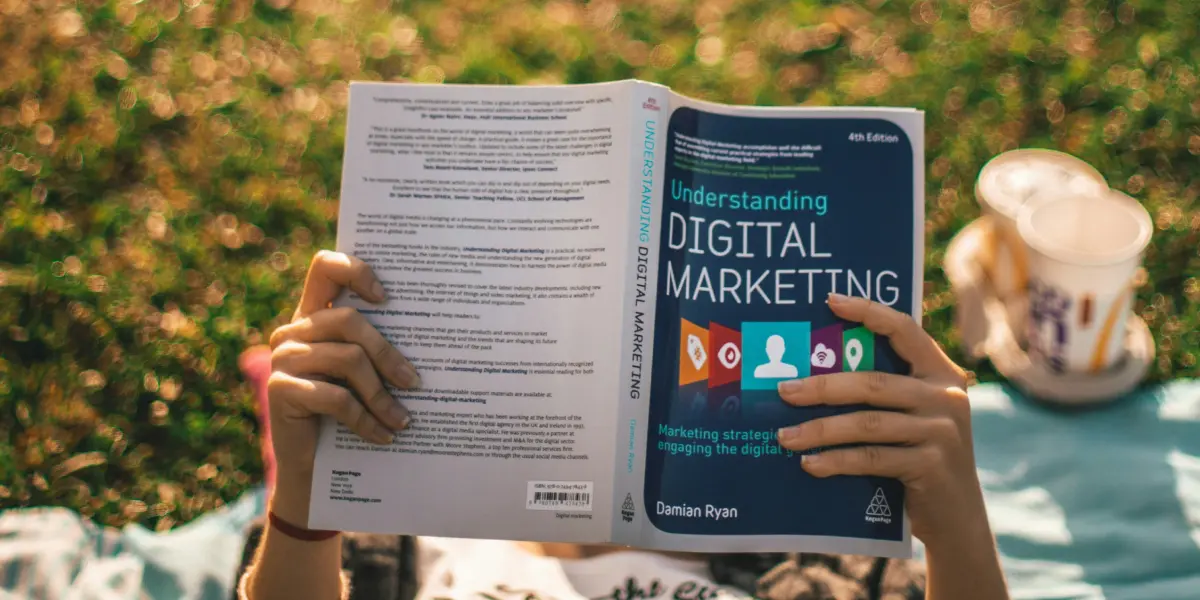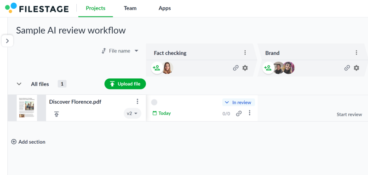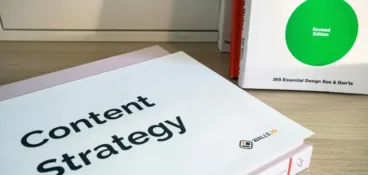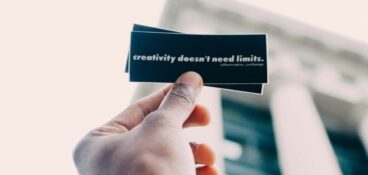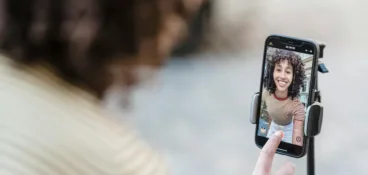43% of marketers say creating consistently high-quality visual content is one of their biggest challenges. And it’s no wonder.
Copyright issues, differing size requirements, lengthy creation and review times … visual content marketing isn’t without its bottlenecks.
Here’s the issue. Underusing videos and graphics could put your brand at a pretty big disadvantage. Because while you’re relying on text-heavy content, your competitors are gaining ground with their visual content marketing strategies.
For example, did you know readers are 30 times more likely to read an infographic than a written article? That explains why including imagery can increase traffic by as much as 12%.
You see, the research is clear, visual content marketing is where it’s at in 2024.
To help you stay on top of the latest visual trends and best practices, I’ve put together this guide. It’s essential reading for marketers, creatives, and freelancers looking to get more wins from their visual content strategy.
What is visual content marketing?
I’ll not bore you with a lengthy visual content marketing definition. If you’ve landed here, you probably already have a pretty good idea of what’s up.
But just so we’re all on the same page, here’s a quick summary:
Visual content marketing involves strategically using images, videos, infographics, and GIFs to communicate with your target audience, engage them, and share stories.
When we consider that people retain 65% of information if the content contains an image, it’s clear to see how this strategy can grab attention and keep your brand at the top of your audience’s mind.
And this is true across all social media platforms and channels.
For example, LinkedIn posts with images boast a 98% higher comment rate. And tweets with visual content receive 150% more retweets than posts without images.

Source: Imgur
Top five benefits of visual content marketing
Let’s be honest. Visual content creation isn’t easy, especially if you don’t have an in-house designer. But the payoff is more than worth it.
Great imagery doesn’t just make your content more aesthetic and eye-catching. It can also drive sales.
Here are just some of the biggest advantages of including visual elements in your content marketing campaigns:
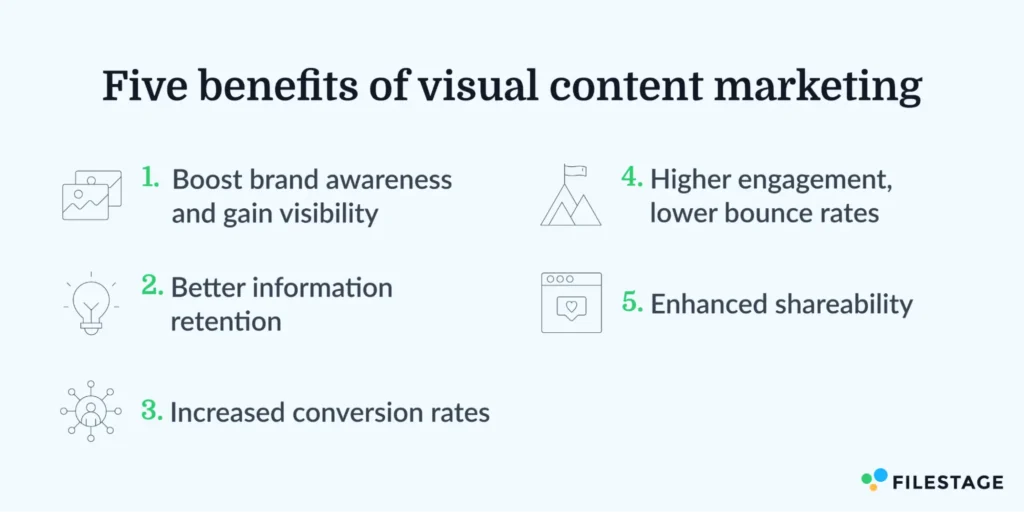
1. Boost brand awareness
Branded images can get your company’s content in front of a wider audience, growing your visibility across multiple platforms. 🌱
Interestingly, video marketing is the runaway winner here.
Forbes research shows that 95% of marketers say video marketing has increased brand awareness.
2. Higher engagement
Images break up text-heavy content, making it more readable and engaging for your audience. And you know what that means: more likes, shares, and interactions.
Not convinced? Data shows that social posts with images garner a 650% higher engagement rate.
This engagement spike goes for blog content and websites, too.
Data from Forbes Advisor revealed that 87% of marketers say video content has helped reduce their website’s bounce rate by keeping viewers engaged for longer.
Most of us are visual learners, which means a blog post with data visualizations tends to stick more.
Interestingly, 21% of content marketers use visual content to increase dwell time. This makes a lot of sense when we consider that 43% of readers skim blogs.
Supercharge your marketing reviews
Share, review, and approve all your content in one place with Filestage.
3. Enhanced information retention
Remember earlier in this guide when I told you that people retain 65% of information if the content contains an image? No? I should have made it an image beside it. 🤦
What I didn’t tell you is that when there’s no image involved, they remember just 10% of the information three days after seeing it. That’s a big difference.
Attractive images and videos are easier for our brains to digest. This means we can create a stronger memory association and retain the information more efficiently.
Why does this matter?
Because the more memorable your content is, the more likely your audience is to share it or talk about it with others. And when it comes to making purchasing decisions, well your brand’s already fresh in their minds.
4. Increased content shareability
Adding social sharing buttons to your visuals can get your content in front of a larger audience and gain you new followers.
Not to mention, images are SEO-friendly. When you include proper alt tags, they can appear on image search engines for relevant keywords.
And the more shares your content gets, the more backlinks you can build for your site. Hello, higher search engine rankings. 👋
5. Higher conversion rates
High-quality images, branded video content, and original graphics don’t just help you get that sweet organic traffic. They can also lead to more sales.
Think about your product pages.
67% of consumers report that the quality of product images is “very important” to them when choosing to make a purchase. This means nailing your visual content marketing strategy across your website and social platforms could directly impact your bottom line.
Types of visual content
When I say visual content, I don’t just mean sticking in some videos or creating infographics. After all, variety is the spice of life.
The key to a successful content marketing strategy is getting the balance right. Some types of visual experiences work best for certain audiences, contexts, or platforms. So the trick is figuring out which is best for the story you want to tell.
To inspire you, here’s a list of the most common types of visual content to add to your arsenal:
- Infographics – perfect for data visualization and summarizing information-heavy content
- Videos – ideal for driving engagement, lead generation, and product education
- Captivating images and photos – best for enhancing blog posts, showcasing products, and leveling up social posts
- Animated GIFs and memes – great for sharing across socials and email to tell stories and jump on current trends (an underrated storytelling tool, if you ask me)
- Calls-to-action – the surefire way to optimize your homepage’s hero section (extra points if it’s animated)
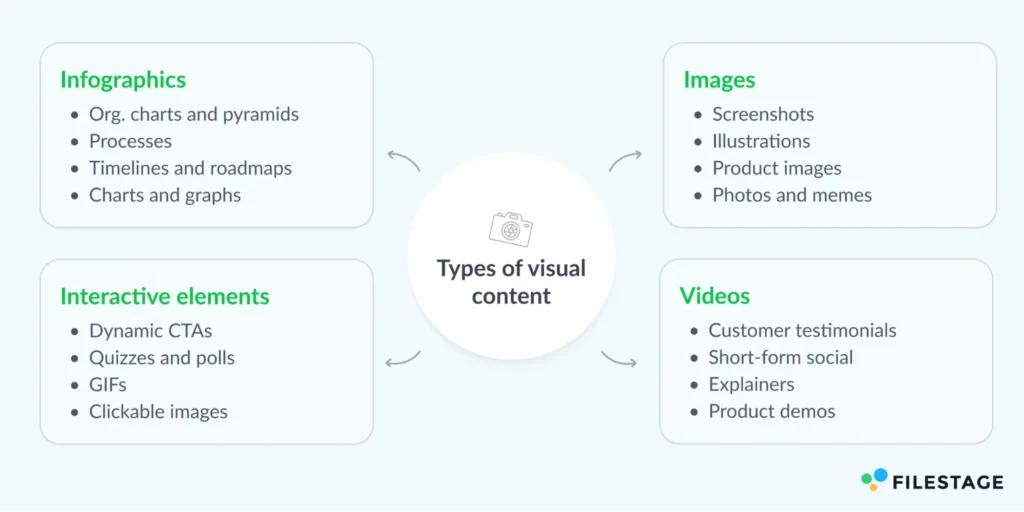
Seven visual content marketing tips (+ best examples)
We’ve seen the statistics. The benefits are clear. But before you jump into the content creation process, you need a game plan.
To help you, I’ve burrowed deep into a research rabbit hole and come up with seven tips to beat the competition with your visual content marketing strategy.
Complete with examples of the brands who are getting it spot on! 😙🤌
1. Think like a storyteller
Who doesn’t love storytime? According to Leapmesh data, everyone does.
Video content has skyrocketed in performance in recent years, showing that today’s consumers crave visual and auditory storytelling.
Before I harp on about the wonders of storytelling, let’s clear one thing up.
Visual storytelling doesn’t always have to be an epic saga. All it really takes is a clear and consistent narrative thread.
Once you’ve found your story, it’s a case of planning your visual media elements to relay it across different platforms. For best results, you may need to tailor your visuals to the platform you’re using.
It’s easy to get bogged down in the hunt for a really great story. But sometimes, it’s as simple as using your color palette and imagery to visually reinforce your brand’s story.
What really matters is having a creative strategy in place.
Start by thinking about:
- What you want to achieve
- Your audience (use real user data to get to know their preferences)
- The problems your brand solves
- Your brand vision and messaging
Next, consider how you can tap into your audience’s emotions.
Take storytelling master Nike.
Case study – Nike’s emotion-driven visual content strategy
The sports brand knows a thing or two about forging an emotional connection with its audience. Through immersive experiences, athlete stories, and motivational imagery, Nike tells us the story of overcoming obstacles.
And it works. The brand has a huge following on its social media channels, great ad engagement, and a community of devoted fans.
Just take a look at this video. In a bid to form a deeper emotional connection with its UK market, Nike gave us this epic hero’s journey through London.
It’s not for everyone. But the real-life stories resonate with its target audience in an authentic way.
2. Know your audience, like really well
I think every marketer out there is looking for that “secret sauce.” A trick or tool that can make your visual content go viral or send conversions through the roof.
And in our noble quest, we sometimes forget the basics: Know thy audience.
It may not be glamorous. It may not be the “quick fix” you crave, but it’s the best way to make sure your content marketing process actually works.
You know what that means, my friends. It’s time to get stuck into your voice of customer data. I’m talking:
- Audience retention rates for your content – What are they loving? What’s leaving them cold? Think topic, length, format, length.
- Engagement – Get your nose in the comments section. What are they saying? Where are you hearing crickets? Here’s where you’ll find the answers you seek.
- Subscriber responses – Do you have a newsletter? Who’s engaging? What’s making them open your email?
AI marketing tools can help you segment your audience and gather the information you need.
Once you’re well and truly acquainted with your audience, make sure your visual content reflects and represents them.
Speaking of representation, let’s talk about Savage X Fenty.
Case study – Savage X Fenty’s inclusive visual content marketing strategy
Rihanna’s lingerie brand can teach us all a thing or two about creating an inclusive brand that represents a diverse audience.
When you think about lingerie companies, a woman in pretty bra sets is usually the first thing that comes to mind.
But this Valentine’s Day social post from Savage X Fenty disrupts all that.
Rihanna’s team bucked the conventional V-Day post we were all expecting and gave us a new message: anyone can be sexy, no matter their age, skin color, or sexual identity. It’s the perfect example of knowing your audience and speaking directly to them with your visuals.

3. Stay on brand
What do the best brands have in common? I’m talking Coca-Cola, Apple, Disney, etc …
They’re excellent storytellers with a consistent visual identity.
Every aspect of their content marketing, product branding, and in-store experience is consistent. You always know when you’re in an Apple store. You instantly recognize that red label with the italic font. Everyone knows the magic of Disney.
They achieve this by making sure their content assets have a consistent visual design across all distribution channels. This may mean tailoring your visuals for optimal quality on each platform.
Using branded templates and design best practices can help you nail this consistency. And don’t forget that this should also apply to video thumbnails, cover images, and any other visual assets.
Adding your brand’s logo to original images and tagging them with relevant keywords and hashtags makes it easy for your audience to find your content.
Are stock images your only option? It’s not ideal, but you can make it work. The trick is to put your brand’s spin on the visuals before using them. For example, try adding your logo and a filter with your color palette.
Case study – McDonald’s consistently branded visual content
You can travel to the most exotic corners of the world, but when you see those golden arches, you know exactly what you’re going to eat.
Welcome to the brilliance of McDonald’s visual identity.
But what’s the secret to having one of the most recognizable brands on the planet? Simplicity.
The brand identity is all about being fun, friendly, and feel-good. And it conveys this with its warm red and yellow color palette, iconic logo, and always-on-point visuals.
It tailors its products to different audience segments, but the visuals remain consistent. Hats off to its content review team!
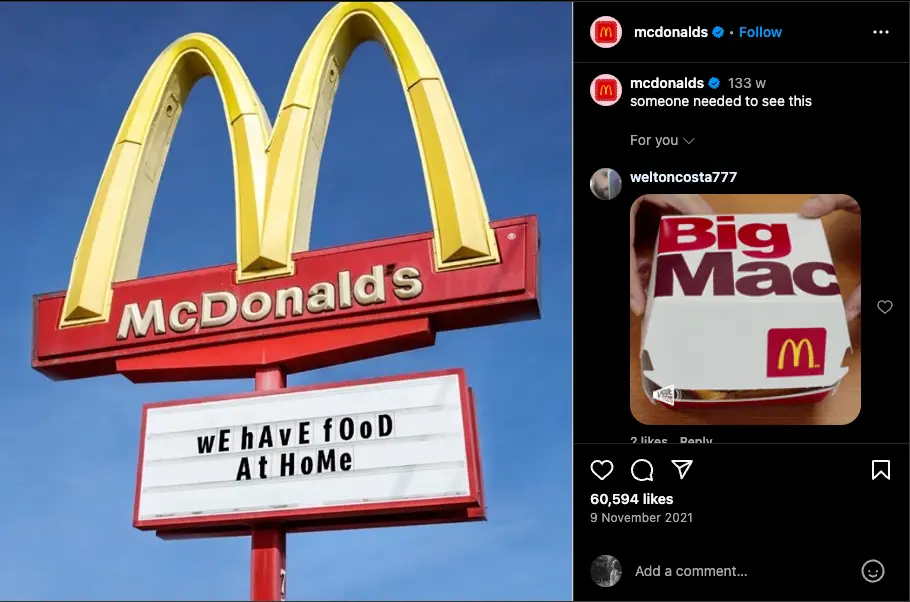
4. Work smarter, not harder
Content creation burnout is real. If your visual content strategy has you spinning on that hamster wheel with no time to rest, then it may be time to rethink your workflows.
More content output and fewer manual tasks, you say? Sign me up. The trick to sustainable content marketing is finding clever ways to cut your creation time without impacting production or quality.
You can achieve this in a number of ways:
- The right content marketing tools can automate repetitive tasks and free up your best brains to work on your next big idea 💡
- Repurpose existing content into visual assets (take blogs, reports, webinars, etc., and turn them into shareable infographics or short videos for social media)
- Get your audience involved in the content development process
If these work-smart ideas inspired you, take a look at these workflow automation examples to really get your creative juices flowing.
Now let’s talk user generated content (UGC).
Case study – GoPro’s genius UGC social media strategy
All your favorite brands are doing it. Heck, Abercrombie & Fitch even used it to do a full brand refresh.
Adding your consumers’ pictures and videos to your marketing strategy can help you meet the demand for high output of branded visual content.
And no brand does it better than GoPro.
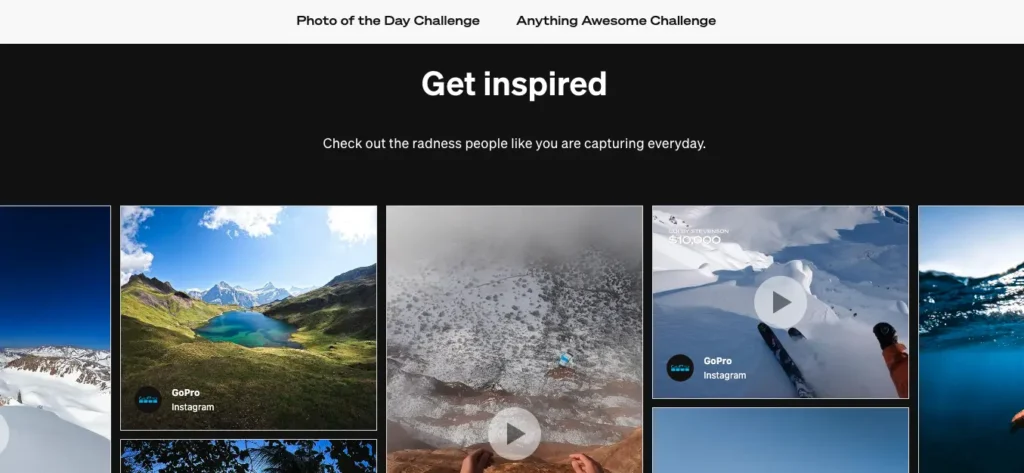
Source: GoPro
It all started by accident. Back in 2014, GoPro released its new Hero 2 camera, the first device to shoot HD video.
In an organic twist of fate, people started sharing clips of how they used their GoPro. YouTube and other social platforms were inundated with footage of babies’ first steps and users attempting adrenaline-pumping sporting feats.
Sales went through the roof, and a new marketing strategy was born.
GoPro launched its first UGC contest in 2018, called the “Million Dollar Challenge.” It encouraged GoPro users to share their best clips to be in with a chance of winning a portion of the million-dollar cash pot. Over 25,000 people participated, and the content is now an annual event.
Since then, the brand has expanded its UGC strategy, launching its “Photo of the Day” and “Anything Awesome” challenges.
According to one case study, now more than 50% of its video content, 80% of its social media photos, and 40% of its website imagery come from users.
5. Prioritize accessibility in your marketing efforts
This is your friendly reminder that not all of your audience will experience visual content in the same way.
Your content should be inclusive, reflecting diverse audiences and consumption contexts.
Here are some ways to make your visual content more accessible:
- Use alt-text descriptions to help visually impaired users consume your content – screen readers will read this text to describe the image and its details
- Run your images through online color contrast tools to check their readability
- Include closed captions in all your social videos
- Add transcripts to describe your videos to people with impaired hearing
- Remember that screen readers translate emojis to words, which can confuse part of your audience if you overuse them
Case study – Gucci’s accessible social media posts
I’ll admit that when I think of Gucci, accessibility isn’t the first word that comes to mind.
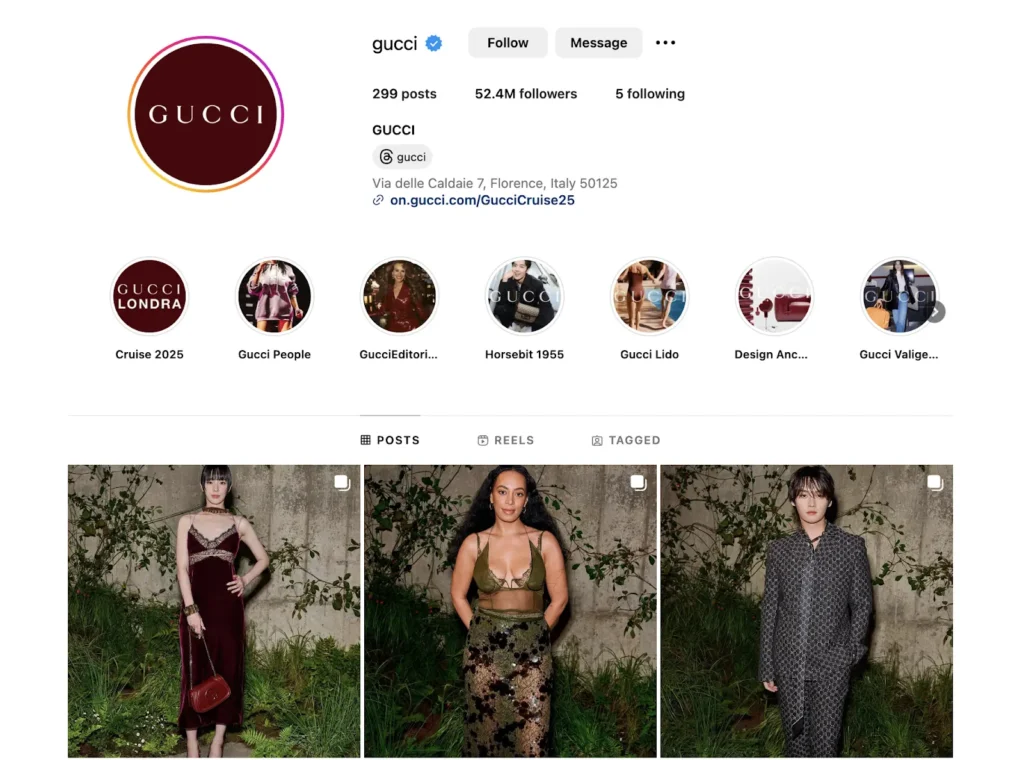
Source: Instagram
But, the luxury fashion brand has taken great strides to make its social media content more accessible.
Gucci now follows social media accessibility guidelines and best practices, such as adding alt text to its posts and enhancing the readability of its content.
6. Understand image copyright rules
Now for the not-so-glamorous part of creating great visual content. One major hurdle in your way is sourcing images without breaching copyright laws.
This means reading the fine print when using stock images, templates, and other photos. And when in doubt, ask the image owner to clarify.
If you have artists who create your visual assets, a clear contract is critical. It should cover all things licensing, including your intention for the art and ownership rights.
It’s not always necessary to credit the artist, but it’s good practice to do this anyway (including when sharing UGC). Even Disney World always credits the original poster when it shares UGC on Instagram.
AI image generation tools have muddied the waters with this, so it’s always better to be safe than sorry.
Case study – Mashable’s use of copyrighted visual elements
Copyright infringement cases are a common occurrence. But a 2020 case involving Mashable hit the headlines when it raised questions about embedding Instagram posts.
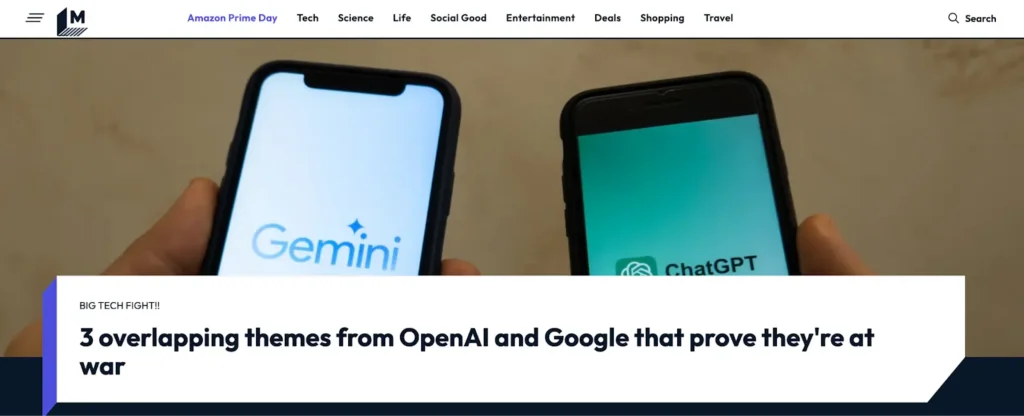
Source: Mashable
Photographer Stephanie Sinclair sued Mashable for using her photos on its website after she denied them permission.
When Sinclair refused, Mashable decided to publish the images anyway using Instagram’s embed feature. Sinclair lost the lawsuit.
But it didn’t end there.
A New York court reopened the lawsuit following a similar case involving Newsweek. This led Instagram to announce it doesn’t grant a sub-license to anyone who uses its embed tool to share public photos.
As a result, third-party publishers can no longer embed copyrighted content from Instagram without the proper license or permission of the owner.
7. Use an online proofing tool
High volumes of visual content. Teeny tiny timeframes to deliver them in. Strict compliance regulations to meet.
Welcome to the life of most creatives working in regulated industries like healthcare, consumer goods, logistics, and travel and tourism.
It’s not pretty, but someone’s got to do it.
Your best bet here is to build a robust review and approval process. With the right online proofing tool, you can reduce review rounds and cut the approval process.
More importantly, you can manage the feedback process to make sure all major stakeholders leave their comments before sign-off.
If you’re like me and wake up in the middle of the night in a cold sweat, worrying about a typo in your content, this is your answer.
In this quick video, our CEO shows you how online proofing software works.
With Filestage, you can easily:
- Include reviewers at different stages of the design review process
- Annotate and leave feedback on visual content like artwork, videos, images, and social posts
- Consolidate and track all revisions on a single content deliverable
- Manage version control to make sure you’re always working off the latest content iteration
- Slash the time spent searching for lost feedback in neverending email threads
- Easily spot and flag inconsistencies or errors in your visual assets
- Integrate Filestage with other visual content tools for a seamless workflow
Case study – VideoBoost’s airtight review and approval process
Since its launch, VideoBoost has created over 3,000 videos for global brands like E.ON, 3M, and Merck.
But it was struggling to collect client feedback in a streamlined way, leading to misunderstandings and wasted time. Having to share pre-versions of unfinished videos with its clients was also causing issues.
Since it implemented Filestage, VideoBoost has built an efficient creative feedback system. Clients can comment on the exact spot on the visual asset, leave feedback, and annotate content. They’ve now reduced the number of emails during the approval process by around 20% and cut the number of file versions needed for their video content. 💪

“During the approval process we need on average 1-2 review rounds less per approval, and we send and receive about 20% fewer emails.”
Stephanie Isabelle Flaig, Head of Operations
Supercharge your marketing reviews
Share, review, and approve all your content in one place with Filestage.
Next steps
Visual content marketing may not be a quick win. But it’s certainly worth it.
Sky-high engagement, increased brand visibility, higher conversion rates – the benefits speak for themselves.
One of the biggest digital content creation hurdles for marketers is finding the right tools to speed up the production and review of visual assets. This is especially true in regulated industries where content faces strict compliance standards.
The right content marketing tool and online proofing platform can give you the upper hand here.
Together, they allow you to create captivating visual assets faster and streamline the review and approval process. That way, you can keep your content marketing strategy on track.
If you’re ready to cut your creative review process by 30%, get a free seven-day Filestage trial today.

